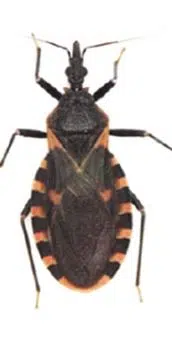During the summer of 2020 entomologists from the Nebraska Department of Agriculture and University of Nebraska-Lincoln Department of Entomology identified a species of kissing bug for the first time in Nebraska.
“Kissing bug” is the common name for a group of bugs called triatomines. These are blood-sucking insects that are found across the Southern United States, Mexico, Central, and South America, especially during the summer months. The species recently detected in Nebraska was identified as the Eastern blood-sucking conenose, which has has been found as far north as Pennsylvania and as far west as Texas.
In addition to sucking blood, kissing bugs carry a parasite that can cause Chagas disease in the people and animals it infects. Although infections from this parasite are not common, approximately 25% of people that are infected develop serious chronic disease, so early diagnosis is important. Infections from the Eastern blood-sucking conenose are even rarer and the risk of infection in Nebraska is considered to be very low.
Where are kissing bugs typically found?
Kissing bugs can live indoors, in cracks and holes of housing, or in a variety of outdoor settings including:1
- Beneath porches
- Between rocky structures
- Under cement
- In rock, wood, brush piles, or beneath bark
- In rodent nests or animal burrows
- In outdoor dog houses or kennels
- In chicken coops or houses
They are mostly nocturnal and are often attracted to lights such as porch lights. Their bite is often painless and usually occurs when a person is still or asleep.
Chagas is a potentially deadly disease caused by a parasite, which is spread to people and animals by the feces of infected kissing bugs.







